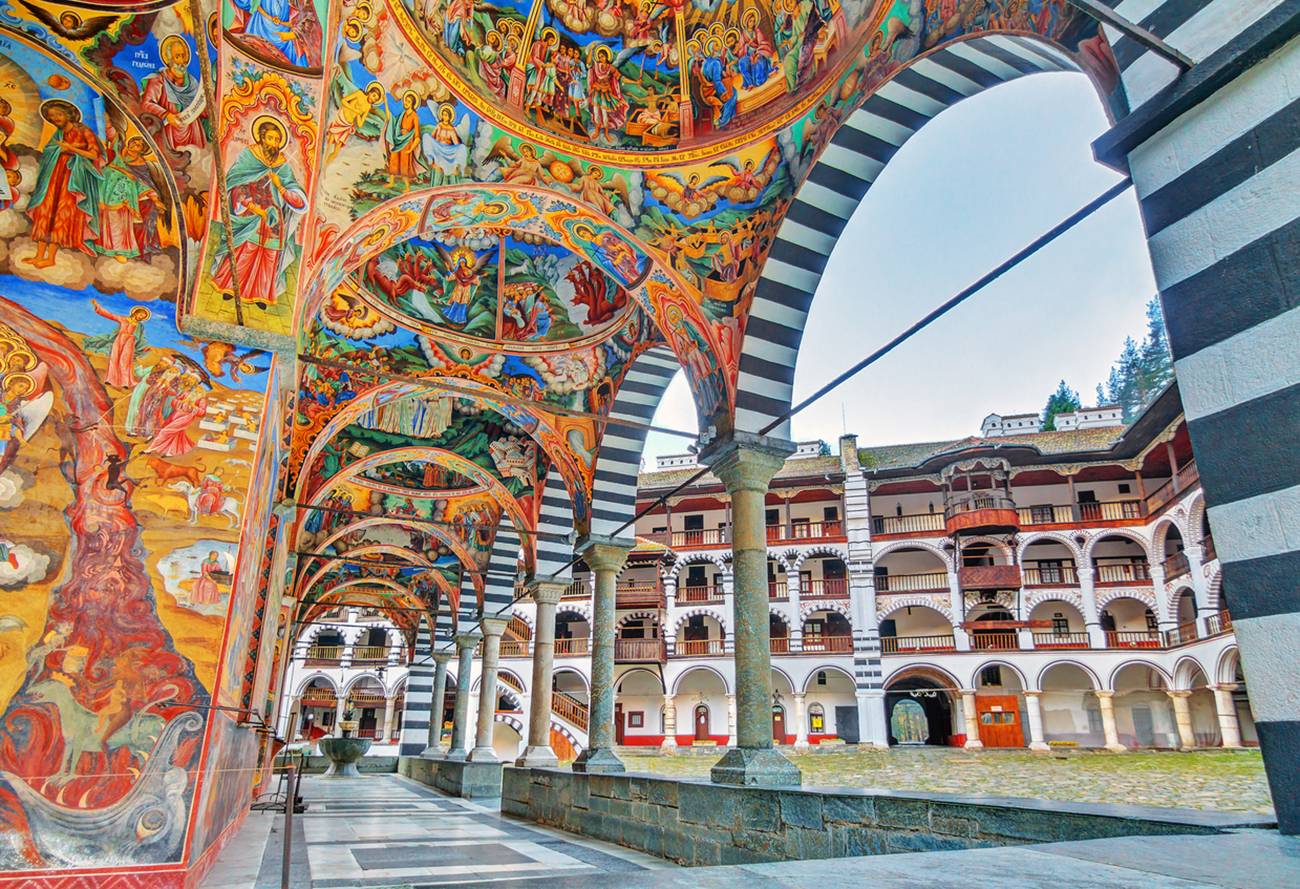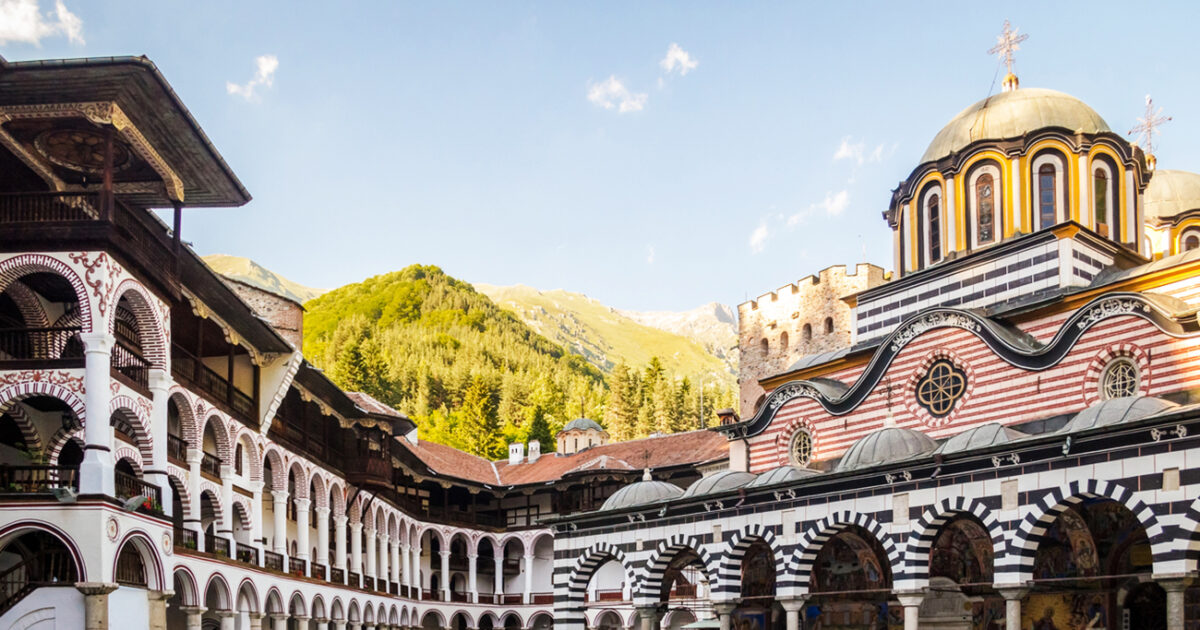The monastery of St. John of Rila, also known as Rila’s monastery, is located in Rila Mountains in Bulgaria And it is one of the most important and imposing religious and cultural monuments in the country.
The story of the monastery begins during the time of Tsar Petros I (927-968). Specifically, the monastery was founded in the 10th century by the Hermitage Saint John of Rila, from whom it was named, one of the respected Saints of the Bulgarian Orthodox Church.
In fact, the Hermitage Saint lived in a cave without material goods near the monastery, built by his disciples.
In fact, the relics of St. John are kept in the monastery.
The monastery is located at an altitude of 1,147 meters, about 120 km south of Sofia, in the River River Valley in a beautiful landscape.
The entire complex of the monastery occupies an area of 8,800 sq.m. In the form of a rectangle, which focuses around the inner courtyard, where the monks’ cells are located, the tower and the central church.
Since its inception, the monastery went through various phases of prosperity and decline, but each time it was regenerated and reinforced by the religious and cultural heritage of the area.
The monastery was always supported and respected by the Bulgarian lords. Great donations were made by almost all the tsars of the second Bulgarian Empire to the Ottoman conquest, making the monastery the cultural and spiritual center of Bulgarian national consciousness, which reached its height from the 12th to the 14th century.
In its current position, the monastery was restored in the first half of the 14th century by Dragolov, a local feudal lord under Serbian sovereignty. The oldest buildings in the complex are dating from this period – the Tower of Debia (1334 – 1335) and a small church right next to it (1343).


At this time there are also the bishopric throne and the rich carved gates of the monastery. However, due to the presence of the Ottomans at the end of the 14th century, numerous raids followed and the destruction of the monastery in the mid -15th century.
However, thanks to donations by Mara Brankovic (daughter of Irene Katakouzenos, from the Byzantine Imperial family of Katakouzin and George Brankovic) and the Russian Monastery of Mount Athos, the Monastery was rebuilt in the late 15th century by the end of the 15th century.
With the actions of Mara Brankovic, the relics of John of Rila were transferred from Tarnovo to the new band in 1469.
The monastery was a guardian of Bulgarian culture and language during the period of foreign domination. At the time of the Bulgarian National Renaissance (18th – 19th century) it was destroyed by fire in 1833 and rebuilt again between 1834 and 1862 with the money of the country’s wealthy citizens, under the famous architect Alex Rilets.
The erection of the accommodation buildings began in 1816, and in 1844 a bell tower was added next to the Tower of Rules. Rila’s Neophytus currently founded a school in the monastery.
At the same time, the Rila Monastery is known for its impressive hagiographies depicting scenes from the Old and New Testaments and its architecture, as it is an excellent example of the Bulgarian National Renaissance. For this reason, it was also proclaimed a National Historical Monument of Bulgaria in 1976 and UNESCO World Heritage Site in 1983.
The central church of the monastery was built in the mid -19th century. It is a single -aisled basilica that has five domes, three holy banks and two side chapels, while one of the most valuable elements inside is the gold -plated iconostasis, famous for its wood carving, for which four craftsmen have worked for five years.
The frescoes, completed in 1946, are the work of many artists from Bansko, Samokov and Razlog, among them the famous Zachari and Dimitar Zograph brothers.
At the same time, the Church houses several valuable images, dating from the 14th to the 19th century. The galleries in the courtyard have influences from the Mameluks with the striped painting and the domes, which became more popular in the Ottoman Empire after the conquest of Egypt.
Inside the central church is forbidden to take photos and videos.
The four -storey (without the underground) building of the complex consists of 300 rooms, four chapels, a mansion, a kitchen (known for its unusual large utensils) and a library, containing 250 manuscripts and 9,000 old forms. The exterior of the complex, with its tall stone walls and small windows, looks more like a fortress than a monastery.
The Museum of the Rila Monastery is especially famous for the cross of Raphael, a wooden cross made of a piece of wood (81 x 43 cm). It was carved by a monk named Raphael, using a fine cut and magnifying lenses for the reproduction of 140 religious scenes and 650 forms in miniature. The work for this artistic lasted twelve years before it was completed in 1802, when the monk lost his light. Inside the museum is forbidden to take photos and videos.
Today, the monastery attracts thousands of believers, who come to worship the relics of St. John and admire its unique architecture.
